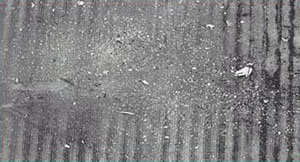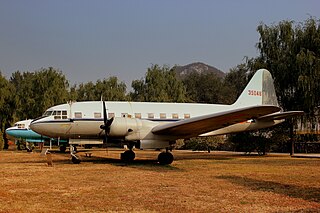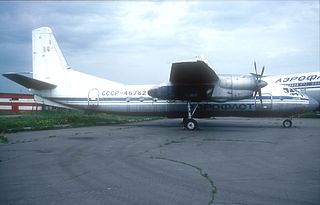
The Antonov An-10 Ukraina is a four-engined turboprop passenger transport aircraft designed in the Soviet Union.

American Eagle Flight 4184, officially operating as Simmons Airlines Flight 4184, was a scheduled domestic passenger flight from Indianapolis, Indiana, to Chicago, Illinois, United States. On October 31, 1994, the ATR 72 performing this route flew into severe icing conditions, lost control and crashed into a field, killing all 68 people on board in the high-speed impact.

The Ilyushin Il-12 is a Soviet twin-engine cargo aircraft, developed in the mid-1940s for small and medium-haul airline routes and as a military transport.

Aeroflot Flight 5143, a scheduled Tupolev Tu-154 passenger flight, was involved in an aviation accident on July 10, 1985, when it crashed due to a high-attitude stall in the Kyzylkum Desert, near the city of Uchkuduk, which had resulted in the deaths of all of the 200 occupants onboard the flight, making it the deadliest accident in the Soviet Union and Uzbekistan and the deadliest crash of Aeroflot's Tu-154s in service.

The 22 January 1971 Surgut Aeroflot Antonov An-12 crash occurred when an Aeroflot Antonov An-12B, registered CCCP-11000, flying from Omsk Tsentralny Airport, in the Soviet Union's (RSFSR) on 22 January 1971, crashed 15 km (9.3 mi) short of the runway on approach to Surgut International Airport, Surgut, RSFSR. An investigation found the aircraft's ice protection system was ineffective because the engine bleed air valves were closed during the flight; ice therefore built up on the aircraft causing it to go out of control.

Aeroflot Flight 25 was a scheduled domestic passenger flight that crashed on 4 April 1963 in the region of Rybnaya Sloboda, Tatar ASSR, Russian SFSR while en route from Moscow-Sheremetyevo to Krasnoyarsk Airport, Russian SFSR. All 67 people aboard were killed in the accident.

Aeroflot Flight 415 was a domestic scheduled passenger flight operated by Aeroflot from Lviv to Sochi with a stopover in Simferopol. On 28 July 1962 the Antonov An-10 operating the route crashed near Gagra, Abkhaz ASSR, Georgian SSR, killing all 81 passengers and crew on board.

The 31 January 1971 Surgut Aeroflot Antonov An-12 crash occurred when an Aeroflot Antonov An-12B, aircraft registration CCCP-12996, flying from Roshchino International Airport, Tyumen, in the Soviet Union's Russian Soviet Federated Socialist Republic (RSFSR) on 31 January 1971, crashed 13.6 km (8.5 mi) short of the runway on approach to Surgut International Airport, Surgut, RSFSR. An investigation found the aircraft's loss of control was caused by icing.

The 2000 Marsa Brega Short 360 crash occurred on 13 January 2000 when a Swiss-registered Short 360 leased by Avisto ditched into the sea near Marsa Brega in Libya. The aircraft was chartered by Sirte Oil Company to transport oil workers to the city. It was carrying 41 people. Most of the passengers were foreigners. As both engines failed in mid-flight, the crew chose to ditch the aircraft. A total of 21 people died in the crash.

Aeroflot Flight 1080 was a Soviet domestic passenger flight from Sverdlovsk, Russia, to Dzhambul, Kazakhstan, that crashed at night shortly after takeoff on 7 October 1978. All 38 passengers and crew were killed in the crash which occurred when one of the engines failed due to icing during initial climb out. At the time, the crash was the second worst in the history of the Yakovlev Yak-40, which had entered operational service with Aeroflot just ten years prior.

Aeroflot Flight 315 was a regularly scheduled passenger flight operated by Aeroflot from Vnukovo International Airport in Moscow to Lviv Airport in Lviv, Ukraine. On 16 November 1959, the Antonov An-10 operating this flight crashed short of the airport runway while on final approach. All 32 passengers and eight crew members were killed.

On Sunday 3 August 1969 an Antonov An-24 operating Aeroflot Flight N-826 crashed resulting in the death of all 55 people on board. An investigation revealed the cause of the accident was an in flight failure of the propeller attached to "No. 1" (left) engine.

Aeroflot Flight L-51 was a scheduled domestic passenger flight operated by an Antonov An-24 that crashed on approach to Liepāja International Airport on 30 December 1967, resulting in the death of 43 of the 51 people on board. To date, it is the deadliest aviation accident in Latvian history. The investigation revealed the cause of the accident to be pilot error.

Aeroflot Flight N-36 was a scheduled domestic Aeroflot passenger flight from Chernivtsi International Airport to Zhuliany Airport, Ukrainian Soviet Socialist Republic that crashed on 17 December 1976 near Kiev Airport, resulting in 48 fatalities and 7 survivors.

Aeroflot Flight 315 (1960) was a regularly scheduled passenger flight operated by Aeroflot from Vnukovo International Airport in Moscow to Lviv Airport in Lviv, Ukraine; at the time, both were in the Soviet Union. On 26 February 1960, the An-10A operating this flight crashed short of the airport runway while on final approach. 24 passengers and eight crew members were killed, one passenger survived.

Siberian Light Aviation Flight 42 was a domestic Russian scheduled passenger flight from Kedrovy to Tomsk, both in Tomsk Oblast in Siberia. On 16 July 2021, the Antonov An-28 operating the flight suffered icing in the engines leading to a dual engine failure 10 minutes into the flight and crash landed in a remote area in the Vasyugan Swamp in the Bakcharsky District. The pilot suffered a broken leg requiring surgery, but all of the remaining passengers and crew escaped with only minor injuries. An investigation ultimately concluded that the pilots of the aircraft had not activated the anti-icing system, which led to an accumulation of ice, resulting in engine failure. Initially praised as a hero for his handling of the incident, the captain of the flight was ultimately criminally charged for violating safety protocols, leading to the crash.

The Aeroflot Flight H-75 was an aviation accident involving an Antonov An-24B aircraft operated by the Kiev United Aviation Squadron (Aeroflot), which occurred on Sunday, January 6, 1974, near Mukachevo, resulting in the deaths of all 24 people on board.

The 1951 Novosibirsk Il-12 crash was an aviation disaster involving an Ilyushin Il-12P aircraft operated by Aeroflot on 17 November 1951, which resulted in the deaths of 23 people.

Aeroflot Flight F-77 was an An-24B operating from Moscow to Bugulma with an intermediate stop in Cheboksary that crashed near Bugulma on 2 March 1986, resulting in the deaths of all 38 occupants on board.

Aeroflot Flight 37577 was a scheduled domestic flight from Perm to Sovetsky. On November 21, 1989, the An-24B aircraft crashed near Sovetsky, killing 32 of the 40 people on board.















